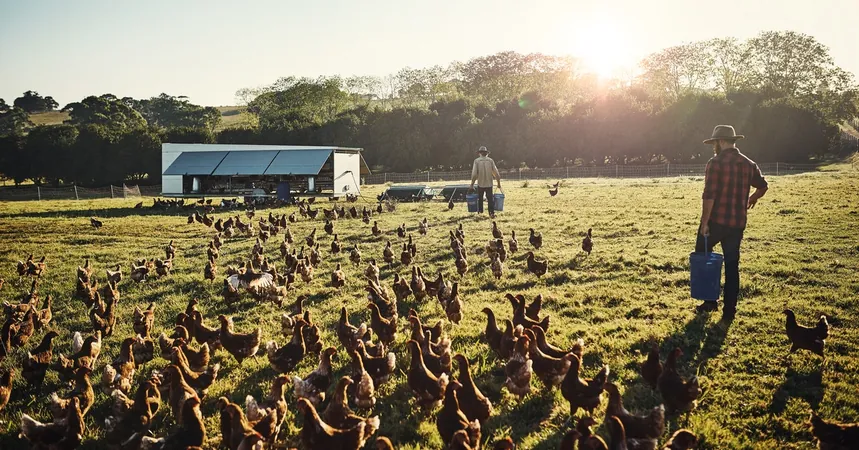
Why Can't You Get a Bird Flu Vaccine in the U.S. Amid a Growing Outbreak?
2025-01-22
Author: Yan
The Current Outbreak of Avian Influenza in the U.S.
As the U.S. battles a severe outbreak of avian influenza affecting birds and dairy cattle, the situation has become increasingly dire. Recently, Georgia documented its first cases in a commercial poultry flock, prompting state officials to halt all poultry sales in a bid to curb further spread. Consequently, egg prices have skyrocketed, leaving consumers struggling to find eggs in stores.
Impact on Human Health
The outbreak isn't just impacting animals; it has also resulted in at least 67 human cases of the virus, predominantly mild but culminating in one tragic death in Louisiana. This individual succumbed to severe complications after being hospitalized, marking the first death linked to the deadly H5N1 strain in the United States.
Vaccine Availability and Government Response
Despite the existence of three licensed H5N1 vaccines for humans, they are not available for public use. The U.S. government has stockpiled millions of doses in anticipation of potential emergencies. However, even amidst increasing cases, federal health officials under President Joe Biden are reluctant to distribute vaccines, emphasizing that the current risk level remains low. Experts argue that a more cautious approach would involve targeting vaccinations for those at higher risk, such as farm workers, rather than a blanket rollout.
Expert Opinions on Vaccination Strategy
William Schaffner, a preventive medicine expert from Vanderbilt University, stated, “From a severity and transmission standpoint, the need to vaccinate the general public isn’t urgent at this time.” So far, human-to-human transmission of H5N1 has not been observed, but health officials are closely monitoring the pathogen for any genetic changes that could make it more transmissible.
Understanding the Transmission of H5N1
The majority of human cases stem from direct contact with infected animals, primarily poultry and dairy cattle. While mild symptoms such as conjunctivitis and mild respiratory issues have been common, health authorities remain vigilant given H5N1's historically high mortality rate—around 50%—among those severely infected.
Protective Measures and Public Awareness
One critical aspect underscored by Shira Doron, an infection control expert, is that vaccination isn't the sole protective measure. Initiatives such as distributing personal protective equipment (PPE) for farm workers and increasing public awareness about avoiding sick animals are paramount. The Administration for Strategic Preparedness and Response is assisting farms by providing essential PPE and antivirals like Tamiflu for symptomatic individuals.
Historical Context of Vaccine Deployment Hesitation
The reluctance to deploy vaccines stems from fears of creating mistrust in public health initiatives. Historical precedence looms large, particularly the 1976 swine flu vaccination campaign, which backfired due to adverse side effects and fostered public skepticism towards vaccination programs.
Future Considerations for Vaccine Deployment
If H5N1 does mutate to become more virulent or transmissible among humans, experts agree that vaccine deployment will be necessary. However, concerns remain about underreported cases, especially among farm workers who may not seek care due to economic pressures or language barriers.
Protecting Poultry Populations and Future Vaccine Research
While vaccines for humans remain in stockpile limbo, the U.S. Department of Agriculture has its own initiatives aimed at protecting poultry populations, which face drastic measures if the virus is detected. With the incoming Trump administration, opinions on vaccination strategies may shift, especially concerning animal vaccines, which could be more politically acceptable.
Advancements in H5N1 Vaccines for Cattle
Significantly, research is also advancing on H5N1 vaccines for cattle, which may stand a better chance of acceptance given the economic stakes within the dairy industry. Vaccination could curb infection rates among cattle, potentially mitigating the risk of human transmission.
Conclusion: The Importance of Vigilance and Innovation
As the battle against H5N1 continues, it’s clear that vigilance and innovative public health strategies will be essential to prevent future outbreaks and protect both animal and human health. The stakes are high, and understanding the intricate dynamics of zoonotic diseases—those that jump from animals to humans—has never been more critical.



 Brasil (PT)
Brasil (PT)
 Canada (EN)
Canada (EN)
 Chile (ES)
Chile (ES)
 Česko (CS)
Česko (CS)
 대한민국 (KO)
대한민국 (KO)
 España (ES)
España (ES)
 France (FR)
France (FR)
 Hong Kong (EN)
Hong Kong (EN)
 Italia (IT)
Italia (IT)
 日本 (JA)
日本 (JA)
 Magyarország (HU)
Magyarország (HU)
 Norge (NO)
Norge (NO)
 Polska (PL)
Polska (PL)
 Schweiz (DE)
Schweiz (DE)
 Singapore (EN)
Singapore (EN)
 Sverige (SV)
Sverige (SV)
 Suomi (FI)
Suomi (FI)
 Türkiye (TR)
Türkiye (TR)
 الإمارات العربية المتحدة (AR)
الإمارات العربية المتحدة (AR)